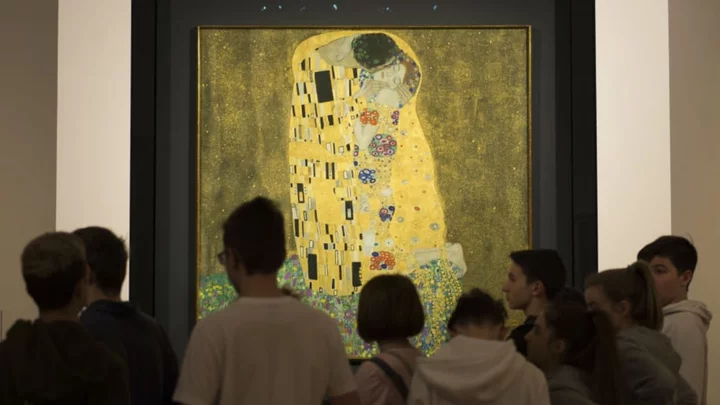Gustav Klimt’s The Kiss is a deceptively simple portrait of lust and love. But beyond that glittery gold leaf, the work is full of fascinating facts.
1. Gustav Klimt’s career was on the downswing when he painted The Kiss.
Before creating The Kiss, Klimt had received scathing scorn in the first decade of the 20th century for his three-part University of Vienna Ceiling Paintings. Because of the nudity in these works, his interpretation of Philosophy, Medicine and Jurisprudence were derided as “pornography” and “perverted excess,” and were ultimately rejected, wounding his reputation.
2. Klimt created his most famous work in a time of creative panic.
In 1907, perhaps reeling from the poor reception of the Vienna Ceiling Paintings, Klimt was sketching furiously, but he doubted his work. He confessed in a letter, “Either I am too old, or too nervous, or too stupid—there must be something wrong.” But before long, he would begin the painting that would be his most popular.
3. It’s a prime example of Klimt’s “Golden Period.”
Inspired by the Byzantine mosaics he’d seen on his travels, Klimt mingled gold leaf into his oil paints to create what would become his signature style.
4. The piece reflects a collision of artistic styles.
The pose of the lovers depicted in The Kiss (Der Kuss in German) reflects the natural forms favored in the Vienna Art Nouveau (or Vienna Jugendstil) movement. But the simple forms and the bold patterns in the pair’s cloaks show the impact of the Arts and Crafts movement, while the use of spirals harkens back to Bronze Age art.
5. The Kiss was a departure from a major Klimt theme.
The painter’s works mostly focused on women, so the inclusion of a man—albeit one whose face is obscured—was unusual for Klimt. The figures’ modest dress also marks this painting as one of Klimt’s more conservative creations.
6. The Kiss may be a self-portrait.
Some art historians have theorized that the lovers seen lip-locked here are none other than the Austrian painter and his long-time partner, fashion designer Emilie Flöge, whom he had previously depicted in a portrait.
7. The woman might be a recurring muse.
As Artsper magazine notes, “the female figure could also be another of Klimt’s many muses or romantic conquests. As Klimt painted relentlessly, he also loved women relentlessly, and had many lovers over his lifetime.” Others have posited that The Kiss’s lovely lady was actually salon hostess and society woman Adele Bloch-Bauer, whom Klimt had painted for a Golden Period portrait in 1907. Still others have suggested the red hair is a clue that this is “Red Hilda,” the model Klimt employed for Danae, Lady with Hat and Feather Boa, and Goldfish.
8. The Kiss was bought before it was finished.
In 1908, the Austrian Gallery displayed The Kiss for the first time, even though Klimt hadn’t yet put the finishing touches on the work. Its unfinished state didn’t stop the Belvedere Museum (a.k.a. The Österreichische Galerie Belvedere) from adding it to their collection on the spot.
9. The Kiss’s sale broke records.
How do you buy a work of art that hasn’t even been finished? You make an offer that can’t be refused. To acquire this transcendent piece of art, the Belvedere paid 25,000 crowns (or about $240,000 in 2011 dollars). Prior to this mammoth sale, the highest price paid for a painting in Austria was a relatively paltry 500 crowns.
10. That price turned out to be a bargain.
Austria considers The Kiss a national treasure, and so the Viennese museum that has long been its home would never dream of selling it. However, if such a transaction were to happen, it’s predicted The Kiss would break sales records again. After all, Klimt’s less renowned (though still quite famous) Adele Bloch-Bauer I sold for $135 million in 2006. The New York Times noted at that time that it was “the highest sum ever paid for a painting.” (Several other paintings have since commanded larger sums, including Klimt’s own Water Serpents II.)
11. The Kiss is arguably blasphemous.
Klimt’s use of gold calls back to the kinds of religious art found in churches. Using gold leaf here to celebrate the earthly pleasures and sensuality of sexuality was considered by some to be profane.
12. It’s really big.
The Kiss measures 71 inches by 71 inches, nearly a 6-foot square.
13. Its shape is often modified for merchandising.
While Klimt’s original composition is a perfect square, the popularity of the painting spurred countless reproductions on posters, postcards, and other mementos. But these souvenirs regularly truncate the right and left sides of the painting to make for a more standard rectangular display.
14. Klimt and The Kiss were minted.
In 2003, Austria released a commemorative 100 euro coin that had a etching of The Kiss on one side, and a portrait of Klimt at work in his studio on the other.
15. The Kiss never disappoints in person.
Maybe it’s the grand scale. Maybe it’s the gold. But when re-assessing The Kiss for Klimt’s 150th birthday, journalist Adrian Brijbassi wrote, “The Kiss by Gustav Klimt surpasses expectations,” unlike that tiny and underwhelming Mona Lisa.
After throwing shade on the more famous painting, Brijbassi explained, “[The Kiss] does what a great piece of art is supposed to do: Hold your gaze, make you admire its aesthetic qualities while trying to discern what’s beyond its superficial aspects.” Take that, Mona.
A version of this story ran in 2015; it has been updated for 2023.
This article was originally published on www.mentalfloss.com as 15 Things You Should Know About Gustav Klimt’s ‘The Kiss’.

